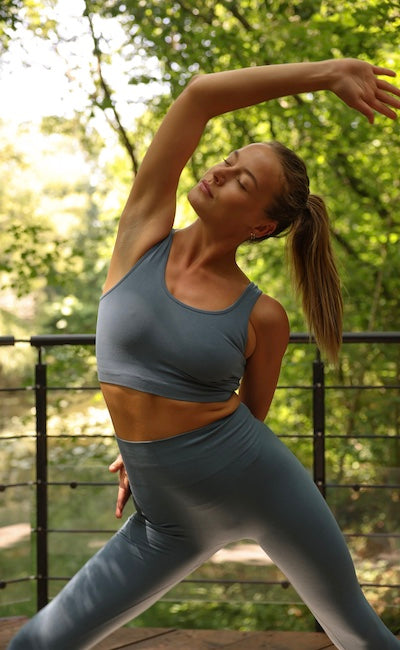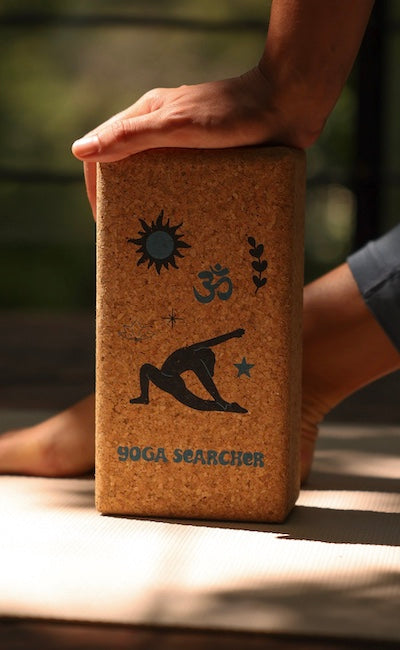Learn the benefits of Pranayama, a yoga breathing technique to improve physical and mental health.
Pranayama breathing , a central element of yoga, involves regulating the breath through different methods and rhythms to improve physical and mental health. This practice has gained popularity in the West due to the many benefits it brings to physical and mental health. But what are the benefits of pranayama and why is it so important for our well-being? This article explores pranayama techniques and their effects on the body and mind, as well as tips for incorporating this breath control into your daily yoga routine.
What is Pranayama breathing?
The fourth pillar of yoga. Pranayama is often practiced alongside yoga and is known as the fourth "anga" or pillar of yoga. It is considered a true science, as it allows one to harness the power of the mind through breath regulation.
The term pranayama comes from two Sanskrit words: “prana” and “ayama”:
- Prana means breath or vital energy,
- Ayama can be interpreted as expansion, prolongation or elevation.
According to yogic beliefs, it is possible to control the inner force ( prana ) through the practice of pranayama. This energy is not limited to the breath, it also represents physical forces such as light, heat and magnetism.
The three phases of Pranayama
Each cycle of pranayama has three phases:
- Puraka , inspiration
- Kumbhaka , retention
- Rechaka , the exhalation
In Pranayama, the regulation of Puraka (inhalation) and Rechaka (exhalation) is achieved by eliminating the natural pause between the two or by prolonging this pause with Kumbhaka (breath retention). This technique aims to control the rhythm of breathing and develop a deeper mastery of the vital energy, or prana , in the body.
The different types of Pranayama
Pranayama can be practiced at a slow or fast pace, depending on the type of exercise chosen. Here are the eight Pranayama breathing techniques:
- Bhastrika pranayama (bellows breathing): An energizing technique that aims to increase energy levels.
- Kapalabhati pranayama (shining skull technique): practiced for its detoxifying and purifying effects.
- Nadi Shodhana pranayama (alternate nostril breathing): It aims to balance the two hemispheres of the brain to center the mind.
- Bhramari pranayama (bee breathing): Used to calm the mind and quiet agitated thoughts.
- Ujjayi pranayama (victorious breathing): A deep, sonorous breath used in Vinyasa or Hatha yoga to improve concentration.
- Shitali pranayama : A cooling breathing technique where air is inhaled through the mouth and exhaled through the nose, cooling the body and calming the mind.
- Viloma pranayama : interrupted breathing that helps increase lung capacity.
- Murcha pranayama : a breathing technique that involves holding one's breath after an inhalation to achieve a state of calm and deep relaxation.
The Role of Breathing in Yoga
Breathing plays a fundamental role in the practice of yoga , synchronizing the body's movements with the breath. This creates a dynamic of breath that allows you to better become aware of your breathing and remain present in the moment.
Yoga classes teach specific breathing techniques , such as Ujjayi or Kapalabhati , that help regulate the flow of life energy during practice. By paying attention to each inhalation and exhalation, conscious breathing becomes a powerful tool for calming the mind and increasing the effectiveness of yoga postures.
What are the benefits of pranayama breathing?

Pranayama offers a multitude of health benefits. By controlling the breath, it is possible to improve the body's oxygenation and strengthen the immune system . The life force, prana , circulates more efficiently, which helps restore balance between body and mind.
How does pranayama affect the mind?
Pranayama is an excellent way to improve mental clarity and reduce stress. By calming the nervous system, it helps maintain emotional balance and better manage stressful situations.
Here is how pranayama affects the mind:
- Concentration : Breathing techniques, such as Nadi Shodhana, increase concentration and focus.
- Stress Reduction : Deep breathing exercises calm emotions and induce a state of relaxation.
- Calm the Mind : Techniques like Ujjayi are particularly effective in calming the mind and relieving tension.
How does pranayama influence physical health?
Pranayama not only impacts the mind, but also physical health . By improving respiratory function and regulating the nervous system, these exercises help strengthen the respiratory system and improve circulation.
Practicing deep breathing also helps increase cellular oxygenation, which stimulates life force and helps improve physical health. To enhance your well-being, it is recommended to incorporate these exercises into a regular practice .
Here are some of the main benefits of pranayama:
- Increases oxygen intake : Slowing down and controlling your breathing promotes better circulation of oxygen throughout the body, which is essential for health.
- Strengthens the immune system : Deep breathing stimulates the respiratory system and helps improve immunity.
- Brings Life Force and Energy : By regulating prana, pranayama increases life energy and contributes to better balance.
- Mental calm and relaxation : Pranayama helps calm the mind, reduces stress, and improves mental clarity, while having positive effects on emotional state.
- Improves Digestion: Pranayama breathing increases oxygen supply to the stomach, thereby improving blood circulation and intestinal strength for better food absorption and digestion.
-
Hypertension Control: Breathing techniques such as Bhramari pranayama (bee breathing) and chanting can help reduce hypertension, thereby lowering the risk of diseases such as stroke, peripheral vascular disease, and coronary heart disease.
How to practice pranayama breathing?
Wondering how to practice pranayama and what the best techniques are? Here's a simple guide to incorporating this breathing practice into your daily life. As you may have read above, there are many pranayama breathing techniques. We recommend starting with simple abdominal breathing exercises before moving on to more complex techniques.

Practice in an airy, open space
Avoid practicing under a fan or in direct sunlight, as this can disrupt your body temperature.
Practice on an empty stomach
Ideally, asanas and pranayama breathing are done before breakfast, so as not to put pressure on the diaphragm or lungs.
Find a comfortable position for a long period of time
Make sure your posture doesn't restrict or strain your breathing. Hatha Yoga Pradipika recommends sitting in the lotus position or on your knees.
Keep your spine straight to maximize the use of your lungs
Use a cushion or folded blanket to help you maintain a comfortable posture, or even sit on a chair if necessary.
Always breathe through your nose unless otherwise instructed
Breathing through the mouth does not filter or warm the air, and dries out the airways.
Focus your mind during pranayama
Focus on your breathing, a mantra, or a specific part of your body. Without concentration, the effect of pranayama is lost.
Practice pranayama after asanas and before meditation
Asanas prepare your body for prolonged sitting, and pranayama helps focus the mind for meditation.
Move slowly and steadily
Progress in pranayama must be gradual and steady, without rushing.
Pranayama Breathing: Techniques to Calm, Revitalize, and Balance
Pranayama, through its many breathing techniques, can affect different aspects of our well-being. Whether you're looking to calm your mind, revitalize your body, or improve your concentration, each pranayama practice has specific benefits.
Bhramari Pranayama (Bee Breath)

Is your mind racing? Can't stop thinking about what someone said about you? Find a quiet corner and try Bhramari pranayama to calm intrusive thoughts. This breathing technique is a real gift for those suffering from high blood pressure.
- Find a comfortable position.
- Close your ears and eyes with your fingers and thumbs.
- Take a deep breath.
- Then exhale slowly, making a buzzing sound, like a bee.
- Continue this for 5 to 10 minutes.
Kapalabhati pranayama
Need to release toxins? Kapalabhati pranayama is one of the most effective practices for detoxifying the body and purifying energy channels.
- Place your hands on your knees, bringing your attention to your belly.
- Inhale deeply through both nostrils.
- Exhale forcefully.
- Focus on exhaling, inhalation should remain passive.
- To start, aim for 65 to 70 cycles per minute.
Bhastrika Pranayama
Lacking energy? Three rounds of Bhastrika pranayama will give you a boost of vitality!
- If you can, sit in Padmasana position with your eyes closed and your spine straight.
- Inhale deeply through your nostrils.
- Then exhale forcefully through your nostrils.
Nadi Shodhana Pranayama
Having trouble concentrating? Try nine rounds of Nadi Shodhan pranayama followed by a short meditation. This technique harmonizes the right and left hemispheres of the brain.
- Sit in a comfortable position with your legs crossed.
- Exhale completely.
- Use your right hand to close your right nostril.
- Inhale deeply through your left nostril.
Incorporating Pranayama into Your Yoga Routine
To fully benefit from the benefits of pranayama, it is recommended to practice it regularly. Here are some tips for incorporating it into your routine:
- Before Meditation : Practice calm breathing like Nadi Shodhana to calm your mind before meditating.
- During Yoga : Use Ujjayi to synchronize your breath with the movements during a dynamic yoga session.
- After an intense session : End a practice with slow breathing exercises to relax the body and refocus your energy.
Pranayama breathing is a powerful way to improve physical and mental health. Whether you're a beginner or an advanced yoga practitioner, incorporating these breathing techniques into your daily routine can help you better manage stress, improve your focus, and enhance your overall well-being. Start exploring the benefits of pranayama today and discover how these techniques can transform your yoga practice.


